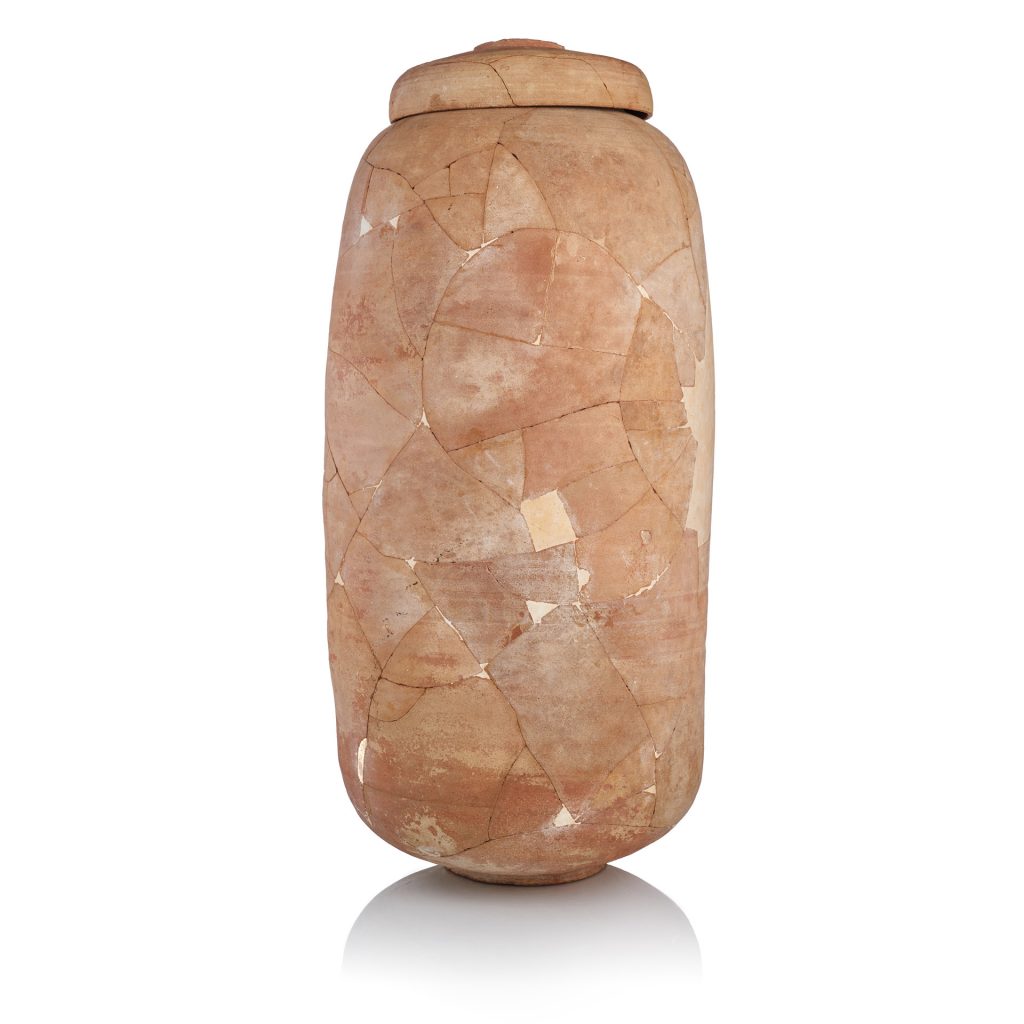“Scroll” Jar and Lid
Qumran, 1st century BCE-1st century CE
Pottery
Courtesy of the Israel Antiquities Authority
Cylinder-shaped jars were found especially in the areas of Qumran, Jericho and Masada. Scroll fragments found in these types of jars gave them the name “scroll jars.” The scrolls themselves include Biblical texts or manuscripts, apocryphal texts, hymns and prayers, wisdom and apocalyptic texts. Some of the non-biblical texts reflect the life and philosophy of a specific community. Qumran community members held firm views regarding and the laws of ritual purity and these jars served to store goods and texts needed to be kept pure
Must Know
It is to be presumed that the Qumran Scrolls (also called the Dead Sea Scrolls, Judean Desert Scrolls and Hidden Scrolls) were written during the period between the middle of the 3rd century BCE and 70 AD. Manuscripts of all the books of the Bible were found in Qumran, except for the Book of Esther. The scrolls include biblical texts from the Old Testament, and non-biblical texts which can be associated with biblical texts from the Second Temple period. Many of the scrolls are written in hebrew and the rest in Aramaic and in Greek. Most of them are written on parchment, some on papyrus and one on copper. Some argue that the scrolls were written by a sect called the Essenes. Before the discovery of the scrolls, the Jewish society was perceived as a homogenous one. However, the scrolls teach us that there had been essential differences between the different streams of Judaism. These came to expression in philosophical disputes on issues such as the status of the Temple and the priesthood, deciding on which calendar to use or how to perceive the world to come. Most of the scrolls were written during the hundred years of Jewish independence under the rule of the high priests of the Hasmonean dynasty. Political tensions within and among the different streams gave rise to the belief that the end of the world was about to come. The seeds of Christianity and Rabbinic Judaism were sown in the light of this historical background. One of the scrolls tells a story about a dispute between the sons of the light and the sons of the darkness. The sons of the light were the Essenes who lived their life in accordance with the solar calendar and therefore all their feasts and major events fell on fixed days. The sons of darkness were the Jewish priests of the Temple who lived their life in accordance with the lunar calendar and therefore had feast days with dates changing from year to year.
More Info
The Essene sect was one of the three main religious movements of Judaism in the Second Temple period. Still, the above theory (i.e. the scrolls were written by the Essenes) was opposed by several researchers who came with various other hypotheses. There were those who attributed the scrolls to the Pharisees, others to the Sadducees, to the early Christians or to the Zealots. Others claimed that the scrolls belonged to the library of the Temple. There were also those who argued that the scrolls were indeed scripts of the Karaites. Disputes regarding the worship in the Temple had led to the formation of the Essene sect, also called “The Witness of the Only”. As a result, the sect retired from the Land of Israel and abandoned the Temple. All its members were exclusively unmarried men who lived together and shared all their property. They had been the very first monastic community in the Western world. They were separatists with the ultimate goal to return to Jerusalem and to restore the purity of the worship of God. However, in 68 CE, the Roman army arrived to the Qumran region and to the Masada to subdue the great revolt and on its way to Jerusalem completely destroyed the settlements.
The scrolls were discovered by a Bedouin shepherd whose name was Mohamed edh-Dib in the fall of 1946. As one of his goats got lost, he threw a stone to a cave to make the goat flee from there, but instead, he found pottery jars and inside them skin fields. he took them for inspection to a local antiques dealer, then returned to the caves nearby and found several other scrolls. The dealer sold the scrolls to Athanasius Yeshue Samuel, a metropolitan bishop of the Syrian community. In November 1947, Professor Eliezer Sukenik learnt about that some ancient manuscripts were for sale, so he went to Bethlehem on the 29 November and purchased two of the scrolls. he determined that these were remnants of the Essenes’ library. Two months later, the rest of the scrolls were offered for sale to Sukenik, but due to the War of Independence and some communicational difficulties, he did not manage to purchase them. The priest fled with the scrolls to the United States and had difficulty selling them, because the scrolls had been smuggled from Israel illegally. In 1954, Yigael Yadin, former Chief of the General Staff and son of Professor Sukenik, came to the United States for a lecture tour and found an advertisement about biblical manuscripts. After some brokerage, he purchased all the scrolls from the priest. The donors who helped to purchase them also helped to launch a book hall at the Israel Museum to present the scrolls to the public. By 1956, another 11 caves and 800 scrolls had been found. The caves were found in different areas in the Judean Desert and the Qumran region by archeologist and by Bedouins who did not given up on the treasures, even after that the archeologist had done so.

